South Carolina
| |
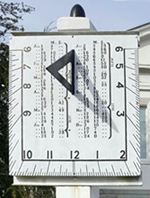 |
Barnwell |
South Carolina |
USA |
Vertical Dial |
Dial 112 |
| This vertical cast iron dial is a rectangle approximately 30x40 inches mounted on a pole. The Barnwell sundial was a gift to the city in Sept 1858 from state senator J.D. Allen, and has continuously shown civil time - accurate to within two minutes - for over 150 years. The vertical dial has an Equation of Time list of corrections for each week, giving the correction in minutes and seconds. A canon ball from the civil war sits atop the sundial. The dial is surrounded by a low circular wall with bronze statuary of a boy walking on the wall and a girl at some distance, looking at the dial. |
| |
| |
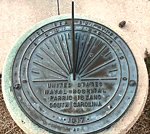 |
Beaufort |
South Carolina |
USA |
Horizontal Dial |
Dial 1014 |
| Farenholt sundial for U.S. Naval Hospital Parris Island SC. This cast bronze dial was designed and commissioned by RADM Farenholt for U.S. Naval Hospitals at bases where he was commanding officer, visited, or had special meaning to him. The dial is 18 inches (46cm) in diameter. The outer chapter ring has the motto, followed by a chapter ring with Arabic hours 6am to 6pm, raised hour lines that radiate from near the foot of the gnomon and short half-hour lines. The gnomon has graceful curves and a star cut-out in the center. Below the gnomon is the naval command name, followed by the commissioning date in the southern portion of the hours chapter ring. |
| |
| |
 |
Charleston |
South Carolina |
USA |
Vertical Dial |
Dial 361 |
| A 20-ft (6m) high stone monument with a 2-ft (0.6m) side at the base holds a vertical reclining sundial. The monument at the base includes stones from the thirty-eight home states of those lost at sead during the collision of the USS Hobson (DD-464) and USS Wasp (CV-18). Embedded in the in the monument is a bronze arrow, pointing to the unmarked graves in the Atlantic. |
| |
| |
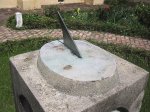 |
Charleston |
South Carolina |
USA |
Horizontal Dial |
Dial 718 |
| A weathered 10 by 15 inch oval marble horizontal dial with bronze gnomon. Dial face has hour lines with Roman numerals showing standard time. Dial sits atop a concrete pedestal with two steps at base. Pedestal has insets on faces, one of which carries a marble plaque with barely readable inscription. |
| |
| |
|
Chesterfield |
South Carolina |
USA |
Armillary Sphere |
Dial 274 |
| ca 20' Bronze Spherical bronze sundial consisting of three intersecting circles supporting an arrow shaped gnomon. Open mouthed gargoyles surround the column's highly carved capital atop a white octagonal column 33 inches high. |
| |
| |
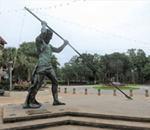 |
Hilton Head |
South Carolina |
USA |
Horizontal Dial |
Dial 1071 |
| A self-proclaimed "World's Largest Figurative Sundial" centers on a 12 foot (3.6m), 3000 pound (1360 kg) statue of Neptune. His trident, set at an angle of 32 degrees, serves as the gnomon. This massive structure sits on a low dais 26 feet (8m) in diameter, surrounded by low octagonal steps. Neptune is an impressive sculpture by Wayne Edwards. But the hour lines are a disaster. "Edwards enlisted the help of experts Frank Yerkes and Richard Hamilton of the engineering firm Sea Island Engineering, now known as Sea Island Land Survey, LLC" They could find north (and there is an "N" in the chapter ring indicating true north, but regardless of the story about sighting Polaris, the noon mark is aligned -8 degrees to the west, pointing to magnetic north). More serious is the marking of hour lines from IV (am) to VIII (pm). The VI hour lines are opposite, but drawn to the center of the dais that is easily 9 feet (3m) from the base of the trident gnomon where they belong. This great structure will never tell solar time. |
| |
| |
 |
Murrells Inlet |
South Carolina |
USA |
Horizontal Dial |
Dial 283 |
| This graceful 10 foot bronze sundial is a model of Paul Manship's dial "Time and Fates of Man" made for the 1939 New York World's Fair. The 1939 dial was made of plaster and stood 80 feet tall, claiming to be the biggest sundial in the world. |
| |
| |
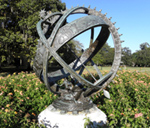 |
Murrells Inlet |
South Carolina |
USA |
Armillary Sphere |
Dial 303 |
| This bronze armillary titled "Cycle of Life"is one of several by Paul Manship in the 20's. The equatorial band has Roman hour numbers on the inside and ornate signs of the zodiac on the outside. Also on the dial are the four elements of earth, fire, water, and air. In the center are three figures of a man, woman, and child symbolizing the cycle of life. |
| |